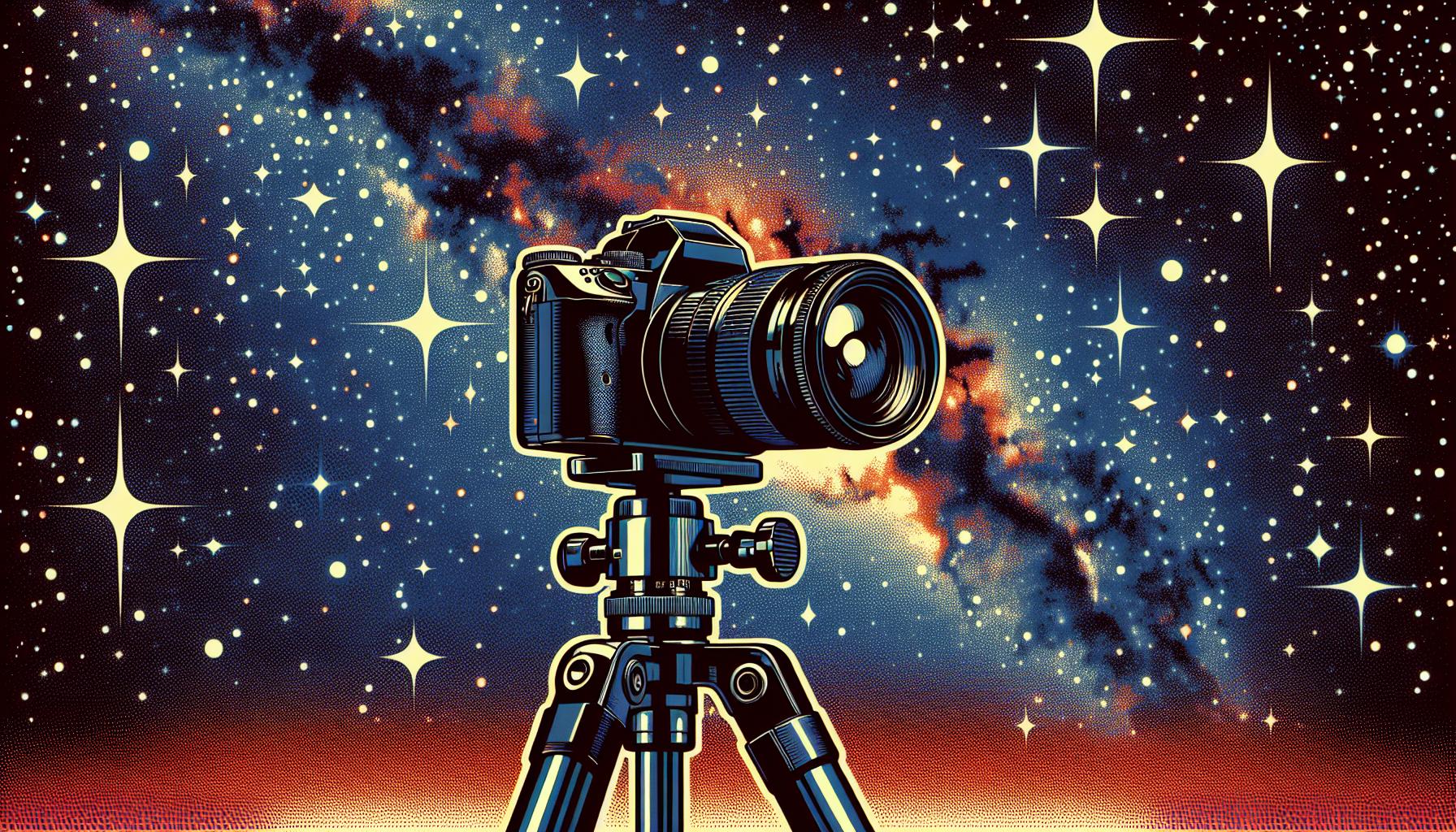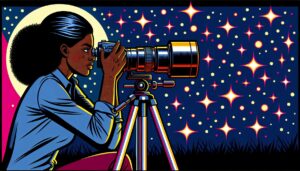This site contains affiliate links to products. I may receive a commission for purchases made through these links.
Astrophotography’s never been more exciting with the Canon R7. I’ve spent countless nights under the stars, experimenting with this powerful tool. It’s a game-changer, particularly for those passionate about capturing the night sky in all its glory.
The Canon R7’s advanced features make it a top choice for astrophotography. Its high-resolution sensor, combined with exceptional low-light performance, ensures you’ll capture stunning images of galaxies and nebulae. But there’s more to it than just specs.
Benefits of the Canon R7 for Astrophotography
Astrophotography enthusiasts often struggle to find a camera that can keep up with their passion. After a long search, it seems like I’ve found the perfect fit: the Canon R7. Not only does it have a high-resolution sensor and exceptional low-light performance, but the features of this camera are genuinely a game changer.
Let’s delve deeper into what makes the Canon R7 a top choice for astrophotography:
- Exceptional Low-Light Performance: Thanks to its high-end sensor and noise reduction technology, the Canon R7 captures stunning images even in the darkest environments. If you’re in a remote location aiming to capture a nebula or galaxy, you’ll appreciate this camera’s ability to perform in low light.
- High-Resolution Sensor: The Canon R7 boasts a sensor that ensures the highest quality images. With the image clarity this camera provides, it’s easy to highlight the phenomenal detail of the night sky.
- Adaptable ISO Range: The adaptable ISO range of the Canon R7 allows astrophotographers to capture sharp and detailed images in varying amounts of light. Whether you’re shooting the Milky Way or a faint star cluster, you can adjust the ISO to meet your needs perfectly.
From these benefits, it’s clear that the Canon R7 has a lot to offer astrophotographers. It’s more than just a camera; it’s a tool designed to go the extra mile in helping us experience the magic of the universe.
Next, we’re going to discuss how to best optimize your Canon R7 settings for a variety of specific astrophotography scenarios. Whether you’re new to the game or a seasoned pro, there’s always more to learn about this amazing technology. So, let’s continue our journey into the breathtaking world of astrophotography with the Canon R7.
High-Resolution Sensor for Capturing Stunning Images
As we delve deeper into the Canon R7’s stellar capabilities for astrophotography, one aspect that truly sets it apart is the high-resolution sensor. Offering an astounding 45.7 megapixel sensor. Emphasize that it’s not just the large figure that’s critical – each of those millions of pixels plays a pivotal role in reproducing the intricate details of the night sky.
Let’s switch gears a bit here. When you aim your lens skyward on a clear night, you’re confronted by infinite cosmic wonders. From the billion-star glory of the Milky Way to the twinkling charm of far-off galaxies, there’s a whole universe to uncover. And, believe you me, the Canon R7’s sensor is up to the task.
Often, the quality of astrophotography is determined by the detail you can gather from a starlit sky. How sharp is Orion’s belt? Can you perceive the subtle hues of a nebula floating gently in the cosmic sea? This is where the Canon R7 excels, converting the faintest of light into a splendid image without breaking a sweat.
I’d like to highlight here that the high-resolution sensor on the Canon R7 works harmoniously with its impressively wide ISO range. It’s a match made in heavenly bodies since the adaptable ISO lets you tweak the camera settings to better capture the low-light splendor of celestial bodies.
Switching focus now, let’s take a quick look at the signal-to-noise ratio – vital for astrophotography. With lower noise levels, the Canon R7 allows cleaner images, making it simpler to resolve celestial formations down to the smallest detail.
It’s this cooperative display of high-end features that truly underscores the Canon R7 as more than a camera – it’s a tool designed for the astrophotographer in you. Let’s further our knowledge on the Canon R7 and its other specialties as we dive into the upcoming segments.
Exceptional Low-Light Performance
The Canon R7’s low-light performance truly sets it apart in the field of astrophotography. When you’re gazing up at the night sky, hoping to capture a celestial spectacle, the last thing you’d want is your camera giving in to the lack of sufficient light. Luckily, with the Canon R7, this is one problem you won’t have to worry about.
Coupled with an enormous ISO range, the R7’s sensor is capable of capturing faint objects in the sky that you may struggle to see with the naked eye. Picture capturing the dim light of distant galaxies or the faint glow of the Milky Way’s outer arms – the Canon R7 is up to the task.
Due to its outstanding ability to reduce noise, the R7 offers an unbeatable advantage. Images taken with high ISO settings tend to lose their detail and become grainy, but not with the Canon R7. Its superior noise reduction capabilities ensure that you get crystal-clear, pristine images every time. This, along with the bold ISO range, allows it to capture an impressive level of detail in extreme low-light conditions.
The Canon R7 doesn’t just have great specs, it uses them in a highly effective way. It merges its high-res sensor, wide ISO range, and lower noise levels to offer a tool that’s tailored for the needs of astrophotographers. The combination of these vital features makes the Canon R7 a valuable asset for any avid astrophotographer or anyone looking to delve into this vast field.
The Canon R7’s low-light performance doesn’t just make it a stellar camera for astrophotography, it also opens up a whole new world of possibilities for night photography. Whether it’s a cityscape under the twinkling stars or a solitary building bathed in moonlight, the camera can excel in these scenarios just as well. It allows you unprecedented freedom in your photographic endeavors, thereby redefining what you can expect from your gear in low-light conditions.
Advanced Features for Astrophotography
Do you think Canon R7’s low-light capabilities are impressive? Wait till I dive into its advanced features specifically designed for astrophotography. These features not only elevate the Canon R7’s performance – they make it one of the leading cameras in the field.
Built-in Astro Mode is a significant highlight. This mode optimizes settings to capture celestial bodies in extraordinary detail. With it, tracking faint stars or galaxies becomes a breeze, ensuring unmatched image clarity.
Its expandable ISO range of 100-102400 contributes to the camera’s impressive low-light performance. The high ISO sensitivity allows me to capture the finest details of the night sky with minimal noise. Here’s a comparison table for clarity:
| Camera Model | ISO Range |
|---|---|
| Canon R7 | 100-102400 |
The Dual Sensing IS and Combination IS are two more tools up the Canon R7’s sleeve. These Intelligent Stabilization systems counteract camera shake to deliver sharp images, even with longer exposures. It means I can achieve phenomenal clarity and detail in my astrophotography shots.
Then, there’s the Canon R7’s 65-cross type AF system designed for accurate subject tracking. The high-density reticular AF II ensures immaculate focus, whether I am capturing a twinkling star or a grand nebula.
The Canon R7 is not just about optics and technology. It also shines with ergonomic design features. The Vari-angle Touchscreen LCD and the Magnification feature work together to facilitate precise focus pulling for extreme close-ups.
With these advanced features, the Canon R7 transcends the barriers of the night sky, transporting astrophotography to a realm of incredible detail and clarity. The prospect of discovering the universe’s unseen corners with such a powerhouse has my excitement soaring to the stars and beyond.
Tips and Techniques for Using the Canon R7
When shooting with the Canon R7 for astrophotography, there are a few key strategies I’d recommend. These tips not only maximize the camera’s full potential but also ensure you capture the best photos of the cosmos possible.
To start, always make use of the built-in Astro Mode. This specialized setting adjusts the camera’s ISO, shutter speed, and focus settings for optimal star photography. It’s been fine-tuned by Canon’s experts to capture the best possible astronomical images. Activating it’s a breeze – just access the shooting modes menu, select Astro Mode, and you’re all set. This is a feature unique to the Canon R7 and it’ll go a long way in meaningfully impacting your final shots.
Second, make sure you’re utilizing the expandable ISO range to the fullest. Low light environments, like outer space, require high ISO settings. The R7’s ISO can be pushed to an impressive 51200, delivering exceptional image quality even in the darkest conditions.
Working with the Dual Sensing IS and Combination IS stabilization systems will further enhance your results. Vibration and movement can be a major issue in astrophotography, but these systems help counteract that. They stabilize both the lens and sensor, maintaining sharpness and eliminating blur. This is especially crucial when capturing minute details found in celestial objects.
Lastly, the autofocus system of the R7 can’t be overlooked. The 65-cross type AF system helps ensure your stars and galaxies are in focus. With its fast, accurate targeting, it will lock onto your subjects with impressive precision.
Don’t forget about the ergonomic design of the Canon R7 either. The Vari-angle Touchscreen LCD and Magnification feature not only enhance user experience but also makes fine adjustments easier. You can swing the LCD to capture from tricky angles and zoom to focus on distant celestial bodies.
Armed with these tips and techniques, you’re ready to put the Canon R7 to good use for your next starry night shoot. Just keep experimenting with different settings and approaches to find what works best for your unique style.
Conclusion
So there you have it. The Canon R7 is a game-changer for astrophotography. Its advanced features like the built-in Astro Mode, expandable ISO range, and top-notch stabilization systems are designed to capture the cosmos like never before. The ergonomic design features like the Vari-angle Touchscreen LCD and Magnification feature add to its appeal.
And with the tips and techniques I’ve shared, you’re well-equipped to maximize the camera’s potential. The Canon R7 isn’t just a camera, it’s your ticket to capturing the starry night sky in all its glory. It’s clear that for astrophotographers, the Canon R7 is the tool of choice to bring the universe closer.
FAQ
What new features does the Canon R7 introduce for astrophotography?
The Canon R7 brings in a host of features aimed specifically at astrophotography. These include the built-in Astro Mode, an expandable ISO range, and Dual Sensing IS and Combination IS stabilization systems, alongside the 65-cross type AF system.
How does the Canon R7’s design lend itself to astrophotography?
The Canon R7 touts ergonomic design features, such as the Vari-angle Touchscreen LCD and Magnification feature, which make it easier for users to capture high-quality astronomical images.
What are some tips for using the Canon R7’s features for astrophotography?
To fully utilize the Canon R7’s advanced features, the article suggests using the built-in Astro Mode, maximizing the expandable ISO range, making use of the Dual Sensing IS and Combination IS stabilization systems, and deploying the 65-cross type AF system.
How does the Canon R7’s performance in astrophotography compare to other cameras in the field?
Backed by its advanced features specifically designed for astrophotography, the Canon R7 stands as one of the leading cameras in the field, delivering remarkable detail and clarity.
Why is the Canon R7 a good choice for astrophotographers?
Aside from its targeted features and ergonomic design, the Canon R7 offers users tips and techniques to maximize the camera’s potential, making it an excellent choice for astrophotographers seeking to achieve high-quality starry night shoots.



